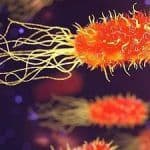The neutrophils are one that reaches the site of the infection quickly when the immune response triggers, and thus helps in fighting against the foreign particles by ingesting them. Eosinophils are another type of white blood cells, that fight against infection, allergies and diseases. Basophils are always present against allergens and prevent blood clotting in the body, as it … [Read more...] about Difference Between Neutrophils, Eosinophils and Basiophils
Microbiology
Difference Between Endotoxin and Exotoxin
Endotoxins are the Lipopolysaccharide-protein complexes (LPS), responsible for making an integral part of the cell wall of Gram-Negative Bacteria and are released at the time of cell death or lysis of bacteria. Exotoxins are the proteins which are secreted by few species of bacteria and get diffuse into the nearby or surrounding medium. Secondly, endotoxins are heat stable, … [Read more...] about Difference Between Endotoxin and Exotoxin
Difference Between Bacteria and Virus
Bacteria are said to occupy the large domain of the prokaryotic cell, while the virus is known as minor infection causing agent. Secondly, bacteria reproduce by themselves through asexual method whereas virus needs a host cell to replicate as they lack cellular machinery but consist of DNA and RNA. When people fall ill, the first thing that struck to their mind is about any … [Read more...] about Difference Between Bacteria and Virus
Difference Between Bacteria and Fungi
Bacteria and Fungi come under different categories; the former one is the prokaryotic cell while the latter one is Eukaryotic cells. Apart from this, there are many differences between them like bacteria need a host to live, and they can be autotrophs as well as heterotrophs, whereas fungi grow their own and are heterotrophs which depend on others for their food. Bacteria do … [Read more...] about Difference Between Bacteria and Fungi
Difference Between Moist Heat and Dry Heat Sterilization
When the process of sterilization is carried out at high -pressure through water (steam) it is called as moist heat sterilization, on the other hand, dry heat sterilization is carried out at high temperature under dry condition. The best way to kill microbes is through 'heat', as it destroys their proteins as well the enzymes present in them. So sterilization (destroying or … [Read more...] about Difference Between Moist Heat and Dry Heat Sterilization





